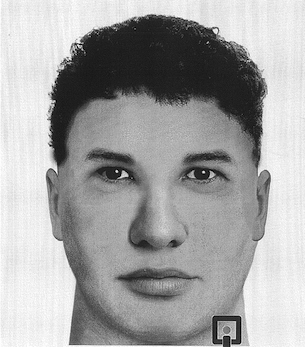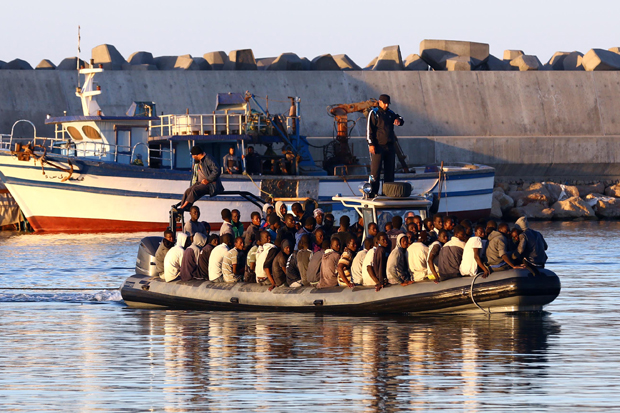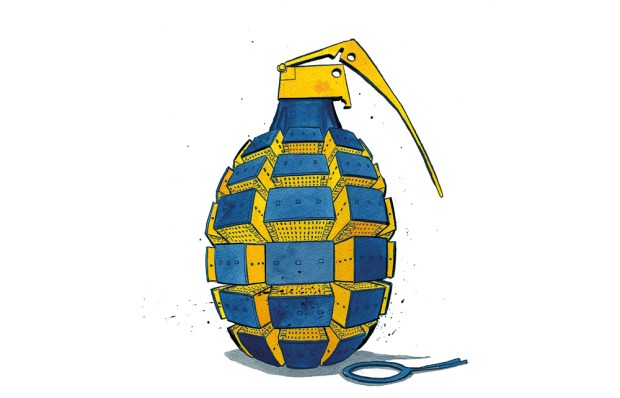It’s Saturday morning in the courtyard of the Al-Zawiyah detention centre on the outskirts of Tripoli and Colonel Nourdeen Mishaal of Libya’s Ministry of Interior’s Department for Combating Illegal Immigration is about to have his weekend ruined. The Colonel has delivered an impassioned speech praising his own government and exhorting the West to do more to help in the battle against the people smugglers responsible for the thousands of migrants arriving in Europe every week.
He dismisses his regime’s pariah status (the Islamist government has no international recognition). If there is a problem with migrants, he states with the full authority of his office, then the blame lies with western intransigence.
It is not long, however, before Colonel Mishaal’s ministerial swagger begins to evaporate. Swatting away the flies in the stinking heat of the prison courtyard, he is not at all prepared for the line of questioning that follows. This includes allegations of brutality and rampant corruption throughout the penal system under his control. Far from combating people-trafficking, it turns out, Mishaal’s men are benefiting from it.
When he demands evidence, we show him the results of Operation Glauco. This is an ongoing 18-month investigation into Africa’s most organised and ruthless people–trafficking organisation conducted by the Italian Squadra Mobile.
In an impressive feat of detection, the Sicily-based cops have compiled over 700 pages of evidence against the trafficking gang. Veterans of the decades-long war against the Sicilian Cosa Nostra (the Mafia), the investigative squad employed all the same techniques that worked against their traditional enemy — including covert surveillance, witness protection and, above all, mobile phone intercepts.
It is evidence from the phone taps that prove the Colonel’s prison officers are bent. In May of last year, one of the top-dog traffickers was taped boasting about how he bribed the guards in the detention centres. Corrupt officers released their inmates for cash, it turned out, and the traffickers would then hold them to ransom. If their relatives failed to pay up, the migrants were severely beaten, the women raped.
The Glauco operation was launched in the aftermath of a tragedy in October 2013, when a vessel carrying several hundred African migrants caught fire off the coast of Lampedusa and sank. There were 366 fatalities — mostly Eritreans fleeing one of the world’s most oppressive regimes.
Pope Francis called the incident ‘a disgrace’ and a task force was quickly assembled. Within weeks the main culprit had been identified: a multinational criminal enterprise operating in Sudan, Libya and the European mainland; the capo di tutti capi of the people-trafficking gang, an Ethiopian called Ghermay Ermias.
Gerry Ferrara, the Sicilian lawyer charged with bringing Ermias to justice, has successfully challenged some of the most ruthless mafiosi, as well as Balkan and Rwandan war criminals. He ranks his latest foe among the worst criminals he has encountered. ‘Ermias is very famous all over Africa,’ Ferrara says. ‘Everybody knows him but at same time it is very difficult to identify him — where he lives, nobody knows.’
Ermias is so elusive that he has never been photographed. The police rely on a photo-fit based on the eyewitness testimony of those he has trafficked. He is short, stocky and in his early thirties. Not much to go on.
Armed with the photo-fit and evidence gathered during Operation Glauco, I travelled with the Sky News documentary team to Libya. Over two weeks we followed in footsteps of Ermias and his gang from their operating bases in the Sahara to their launching points on the shores of the Mediterranean.
Kufra, in the heart of the Libyan desert, was traditionally a staging post on the ancient trans-Saharan slave route from the horn of Africa.
Today this oasis community is the entry point for all types of contraband from petrol, cigarettes and weapons, to human beings. It is a magnet for every thief and cut-throat from half a dozen countries. Ermias and his thugs are particularly active here, transporting vast numbers of Eritreans across the nearby Sudanese border and then on to the northern coast.
Even under the protection of the mayor of Kufra and his extended family from the dominant Zuwayya tribe, we never felt safe. Our hosts were nervous too. When we asked to travel to one of the smugglers’ camps outside the city limits, one of our guards pointed to the black flag of IS that hung in the shimmering haze on a nearby hill and shook his head.
We were allowed out to film what we dubbed ‘the Great Wall of Kufra’. This 150km-long berm, a trench protected by raised banks, which looks as though it might have been constructed around the time of the first Punic War, is in fact modern Libya’s first line of defence against the smugglers.
Like everything else in that benighted land, the fortification is not fit for purpose. The desert sand has drifted to fill the trench. It is easy for the modern-day slavers with their state-of-the-art GPS technology and night-vision goggles to accelerate their turbo-charged 4x4s over the barrier.
Major Taleb Kheir of the region’s anti-immigration task force admitted he has already lost the battle. His men are poorly equipped and easily outgunned by the smugglers. He admits that even if captured, the criminals bribe their way out. Taleb told us he has spoken many times to European and American officials about his difficulties. They promised help. None has been forthcoming.
Further north, on the outskirts of Benghazi, we were taken to one of the front lines. Here, government forces were using their .50-calibre machine-guns to pound a squad of foreign IS fighters who had been holed up for months. They wouldn’t budge.

Benghazi has been a permanent combat zone for almost four years now, ever since the revolution that ousted Colonel Gaddafi. Around the shell-shattered suburbs of the coastal city the western troops of Tripoli battle their sworn enemies from the east, rival militias settle ancient scores, and everyone gangs up against the hated IS.
The never-ending chaos allows Ermias’s criminal enterprise to flourish. The phone taps reveal that last year his gang were moving people — including young children —through Benghazi. The asking price for this stage of the journey alone was $1,700.
In Tripoli we travelled into Abu Salim, the notoriously hostile neighbourhood identified as the location of Ermias’s headquarters. He may still be there — no one knows. Back in April, following the arrest of some of his foot soldiers in Sicily, Ermias switched phones and went offline. When we ventured into the back streets with his photo-fit we were warned off in seconds. Libya is no place for westerners making enquiries.
Europe’s politicians — including Theresa May and David Cameron — have stated that the most effective way to stem the flow of migrants is by smashing the smuggling networks. A team of Scotland Yard officers is due to arrive in Italy in the next few days.
Yet Gerry Ferrara concedes that his chances of catching Ermias are slim. The Italians and their new colleagues from the Met have no jurisdiction in North Africa. Any manhunt will have to rely on local help.
We asked Ferrara who he picks up the phone to in Libya to pursue his enquiries. The normally ebullient prosecutor fell silent. ‘Honestly?’ he replied eventually. ‘No one. I have absolutely no point of contact.’
Ferrara believes that defeating the trafficking networks could take between five and ten years and cooperation from a stable Libya is vital. If arrivals continue at the current rate, it means up to a million refugees from Africa alone arriving on the shores of southern Europe. That is politically unacceptable. But with men as elusive and ruthless as Ghermay Ermias running the trafficking networks — and with desperate families prepared to entrust their lives to his thugs — it is going to take a lot more than outstanding police work to solve Europe’s migrant problem.
Got something to add? Join the discussion and comment below.
Get 10 issues for just $10
Subscribe to The Spectator Australia today for the next 10 magazine issues, plus full online access, for just $10.
World’s Most Wanted: People Smuggler is on Sky One at 10 p.m. on Wednesday 22 July.
You might disagree with half of it, but you’ll enjoy reading all of it. Try your first month for free, then just $2 a week for the remainder of your first year.














Comments
Don't miss out
Join the conversation with other Spectator Australia readers. Subscribe to leave a comment.
SUBSCRIBEAlready a subscriber? Log in